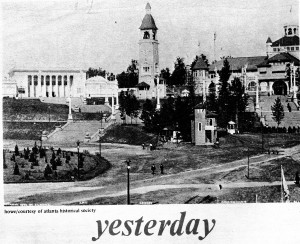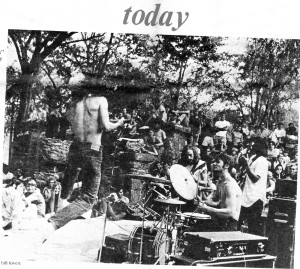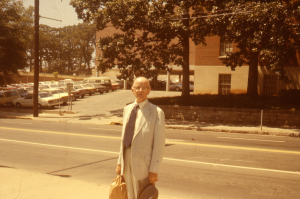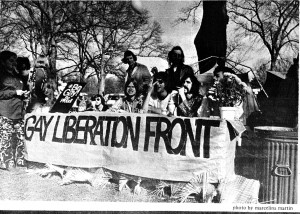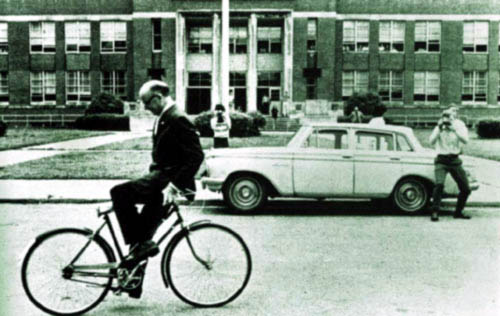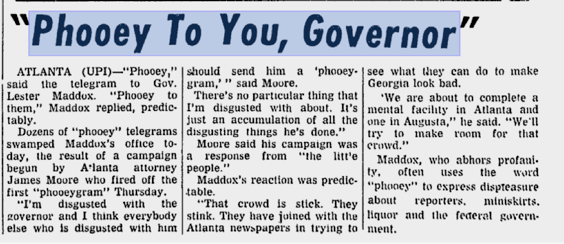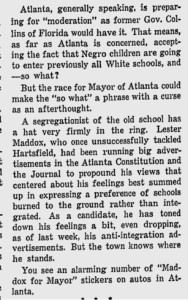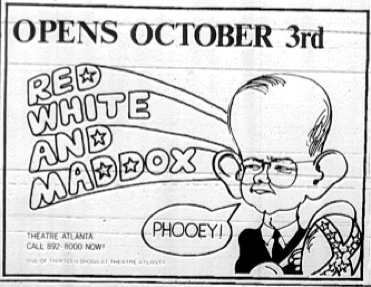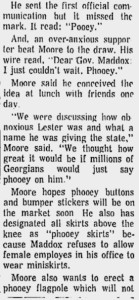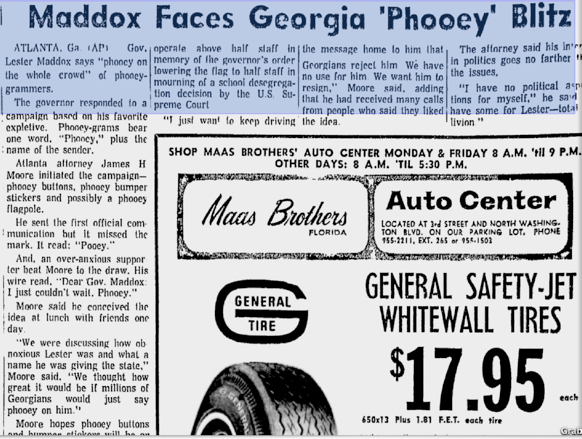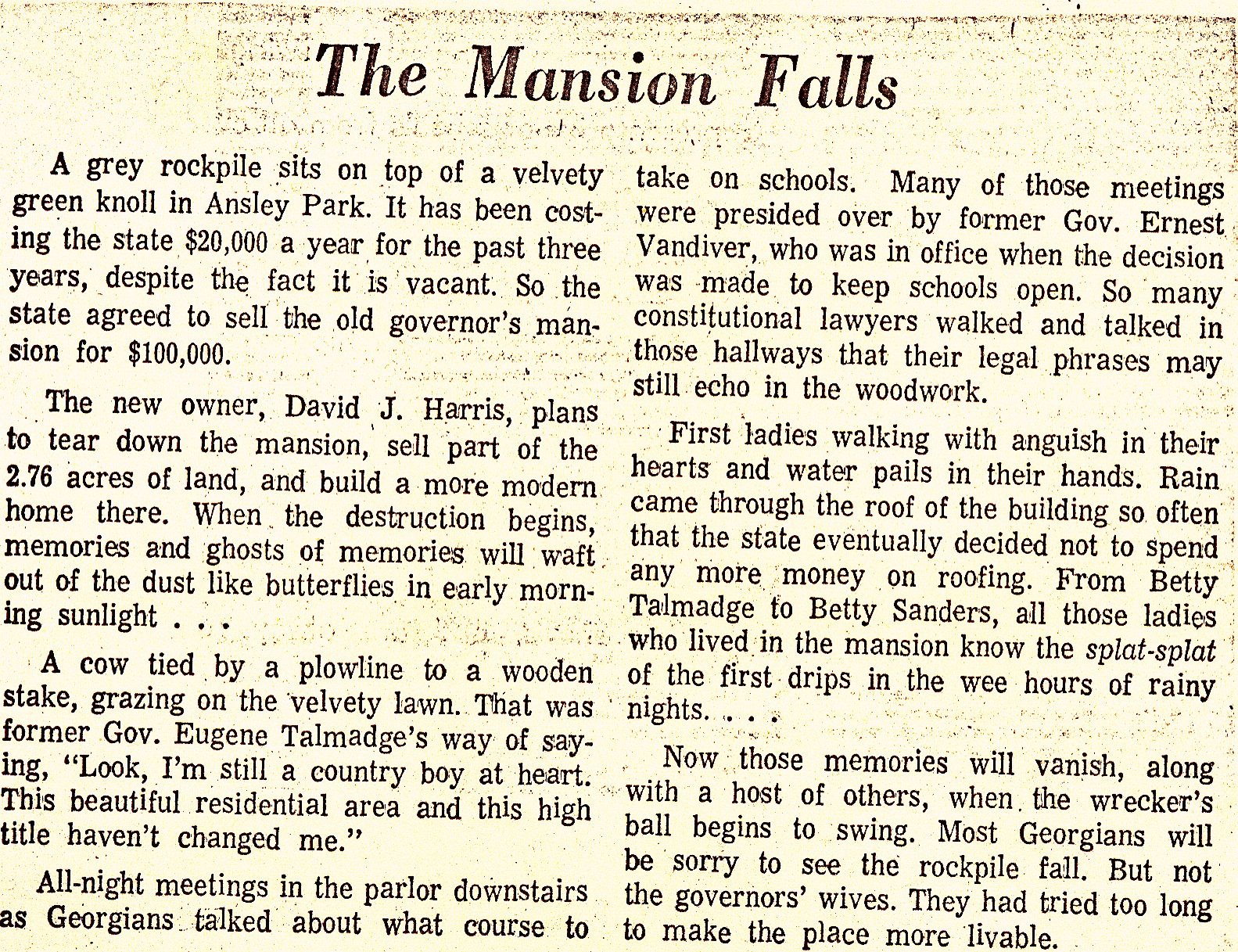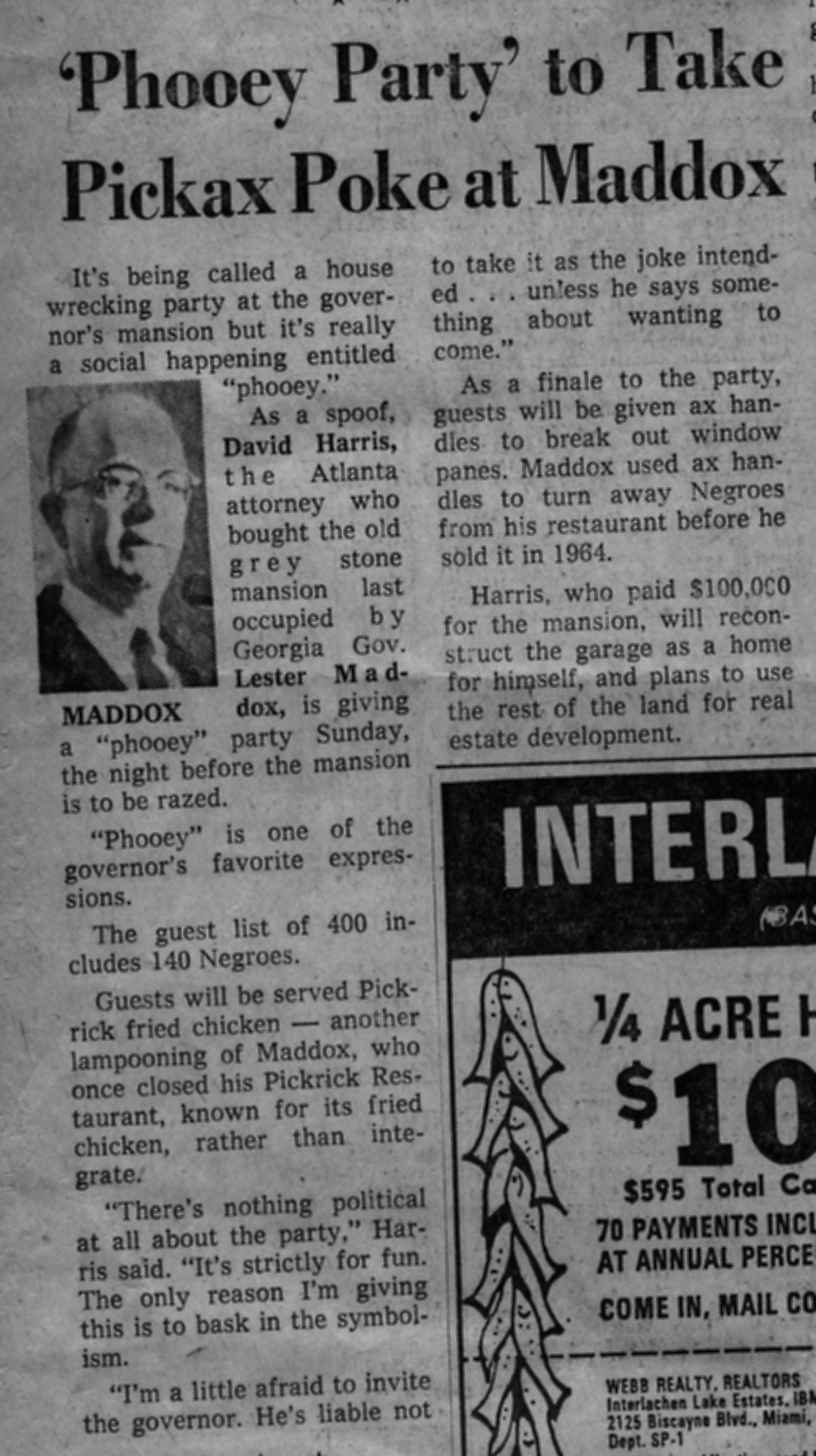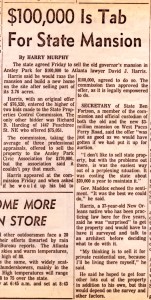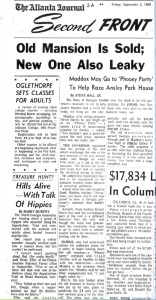Atlanta Time Machine collected a map showing the actual proposed routes expressways planned on just the East side of Atlanta. Take a look and figure out if your neighborhood would still even exist.
Hear is what the historians now say about
The Great Speckled Bird Jan 7, 1974, Vol. 7 #1 pg. 10
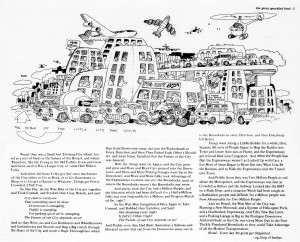 I-485
I-485
The controversy that has been raging over Atlanta’s proposed downtown interstate freeway has been boiling hotter in the past few months, and while the Bird hesitates to make sweeping predictions, the chances for the construction of 1—485 are looking a little dimmer.
For those of you who have just entered the Atlanta scene, 1-485 is a federal interstate freeway that has been proposed for the east side of Atlanta. It would be built to relieve traffic on the downtown connector, or 1-75-85, and would run from near Broadview Plaza south through Morningside, Virginia Highlands, and Inman Park.
1-485 has been planned by the highway builders since the early 1960’s and has been a controversial road since the announcement of construction plans. Most of the opposition to the road stems from the fact that the proposed route runs through the Morningside and Lenox Park neighborhoods which are middle and upper income residential areas and which are very strong close-in neighborhoods. The other area that the road will effect is the Inman Park and Little Five Points neighborhoods, just to the south of Morningside. When the freeway was first announced, most of Inman Park and Little Five Points were strong working class neighborhoods with a portion of lower income transient families. The Bass Organization for Neighborhood Development (BOND) was formed initially to fight against the freeway. However, most of the BOND folks, lacking the power and influence which money brings, felt that about all they could do was push through certain changes in the freeway design which would lessen the impact of the road on their neighborhoods.
The State Highway Department came into the BOND area and cleared out around 600 homes and numerous businesses to make way for the road before most people knew what was happening. When the Morningside and Lenox Park folks saw that the State Highway Department was not joking about this freeway they began to mobilize with court suits and political pressure, to either get the road stopped completely or to insist on changes in the design which would lessen the impact on their neighborhoods.
At the same time that the Morningside-Lenox Park people were getting their act together for an all out fight against the freeway, a change was taking place in the BOND area. Rich folks were moving into Inman Park to restore the few fine old Victorian homes that had been missed by the Highway Department’s bulldozers. These people began to realize just how close this freeway would be coming to their backyards and also began to gear up to oppose the freeway and joined the old time residents of the BOND neighborhood in the fight, bringing with them money, planning expertise and political influence.
Thus, neighborhoods all along the route of 1-485 began to get together to present a united front against the freeway should now take a step back and look at why some people want 1-485 to be built and others do not. The main, up front, reason for planning 485 was to relieve traffic congestion on the downtown freeway. Who could possibly object to that?
However, things are not always as they seem on the surface. 1-485 is a crucial link in a whole series of urban toll roads that the State of Georgia has planned for the Atlanta area. Several years ago the General Assembly created a Georgia Toll Road Authority, with the power to sell construction bonds, build roads and charge tolls for their use in order to retire the construction bonds. This practice, of course, has been used extensively in other parts of the country, but in the past the state has felt that any road that would be a toll road would not generate enough traffic to retire the construction bonds.
Nonetheless, the newly created Toll Road Authority has been looking around for places to build its first toll roads and thought that Atlanta would be able to generate enough traffic for the roads to support themselves. Thus a network of toll roads has been planned for the Atlanta area: the Westside toll road, the Stone Mountain toll road, the Lakewood toll road, and the North Atlanta toll road. ( They got part of one- ed. )The important thing about all of these toll roads is that I-485 is the connecting link between most of the proposed toll roads. If the State of Georgia cannot build 1-485 then the whole toll road network becomes almost impossible to construct as planned. It becomes a meaningless jumble of unconnected road segments.
If the Georgia Department of Transportation is unable to construct I-485 then the newly created Toll road Authority will be hard pressed to justify its existence. And, of course, the highway planners and builders would like to keep their jobs.
It also appears that the Georgia Department of Transportation is concerned about keeping I-485 alive as a project because they will get more money from the federal government for highway construction each year that 1-485 is kept on the list of proposed freeways. The state is under no real obligation to construct 485 if it remains on their list, they just receive more money each year. So the state does have an interest in keeping the project alive, at least on paper.
The downtown boys, representing the central business district interests in the City of Atlanta, are also strongly pushing for the construction of 1-485. They are interested in routing through traffic around the downtown area, which 1-485 would do, so that people who do choose to drive downtown can do so without much hassle. But, also, the downtown boys are very interested in having this series of toll roads built in the Atlanta area. Somehow, people like these equate freeways and toll roads with progress and a healthy business community. However, in the past year or so the business community has had to take a closer look at their position on freeways and 1-485 in specific. They have taken a strong position, on paper at least, for encouraging close-in residential neighborhoods. Their concern is to attract more white middle and upper income families back into the city.
An obvious contradiction lies in the fact that 1-485 will be running through exactly the type of neighborhoods which the business community says that they would like to preserve and encourage. Even most people who support the construction of 485 will admit that these neighborhoods will not be very pleasant to live in once construction of the freeway is started. And opponents of the freeway say that 485 will effectively kill any residential viability that exists in the path of this freeway.
Opponents of the I-485 are objecting to it for several reasons. The first, which has already been mentioned, is that good residential neighborhoods will be destroyed by the construction of the freeway. Second is that MARTA should be fully utilized to provide a transportation system that is a real alternative to the automobile. If we are going to build a rapid transit system we do not need to continue to build additional roads for cars. Also with the energy crisis, either real or fake, we are going to have to reduce our consumption of fossil fuel over the long run and MARTA will help with that effort while another road will only encourage more gasoline consumption.
What is the status of 1-485, will it be constructed or will the idea by canned? It appears that the efforts of the anti-highway people are beginning to payoff.
Their first concrete effort to stop the freeway was in a court suit which asked for an injunction against any construction or additional acquisition of property until an environmental impact statement could be prepared. In July of 1970 an injunction was handed down which stopped construction only two weeks before the State Highway Department was to let the first construction contracts for I-485. The injunction said that no more work could be done on the road until the state prepared an environmental impact statement that was acceptable to the US Department of Transportation. The State Highway Department commissioned Griner and Associates to conduct this environmental study. Griner is the Maryland engineering firm that gained national publicity recently when it was revealed that the firm was involved in Agnew’s indiscretions while Governor of Maryland.
Griner conducted this environmental impact statement, but fortunately the statement was soundly rejected by the federal government last summer. The feds said that the statement did not give an adequate assessment of the construction of rapid transit on the transportation needs for Atlanta, that it did not study effectively the impact of related roads, specifically the proposed toll roads, and that it did not adequately look at alternatives to the road and other route alternatives closely enough.
In effect the federal government said that Georgia could not begin construction until some of these issues were looked at more closely. Meanwhile, several other things are going on that will effect the fate of 1-485.
Perhaps the most interesting thing is the role that the Atlanta Regional Commission is beginning to play in the fate of 1-485. The ARC is charged by Georgia law with planning responsibility within the Atlanta regional area. In the past they have been avid supporters of 1-485 and the road was included in the Atlanta Area Transportation study, which was supposed to be the last word on what transportation improvements would be made in the Atlanta region.
However, this fall the ARC apparently began to back away from its avid support of 485 to a wait-and-see attitude. The ARC omitted I-485 from a list of high-priority items which should be built. However, they say that this does not mean that they are not supporting the project anymore. A new regional transportation plan is being prepared by the planning staff of ARC and final word on their support or opposition will be whether they include the road in their updated transportation plan.
According to one of ARC’S transportation planners, during the process of preparing this plan they will be looking at some of the questions raised by the US Department of Transportation. This indicates that the Georgia DOT is in effect waiting for the ARC to take the lead in justifying the existence of 1-485 and subsequently the toll roads. This obviously places ARC in a pivotal role as far as 1-485 is concerned and also a very powerful one.
The Board of Aldermen have gone on record several times as opposing the construction of 1-485. Most recently they have passed a resolution which could set in motion the actual death of 1-485. In August the US Congress passed the 1973 Federal Highway Act which provides for the transfer of money that has been allocated to highways to local transit authorities. The law says, “Upon the joint request of a state governor and the local governments concerned, the (US Transportation) Secretary may withdraw his approval of an urban interstate, clearing the way for transfer of those funds to the local transit authority.”
The Board of Aldermen, two weeks ago requested that the $70 million of federal money that has been allocated for 1-485 be transferred to MARTA. The only real problem with this is that the governor of the State of Georgia has to also agree to the transfer of funds and apparently Governor Carter is not ready to do that. Carter, in response to the action of the Board of Aldermen said that the Aldermen were not the proper “responsible local officials” and said that the Atlanta Regional Commission is the proper group of local officials to make such a request.
Most observers feel that Carter’s position about ARC is wrong and would not stand if challenged. What will come of this is still unclear. However, the Board of Aldermen did set into motion an interesting action which apparently would be precedent setting and would, more importantly, spell the end of the 1-485 project.
Governor Carter has showed his colors in another way in-the past few months over 1-485 with his 1-485 opinion poll. Carter announced that he was going to commission a poll to find out what the people of the Atlanta area really feel about 1-485 and more freeways in general. He failed to announce that at the same time, and on the same poll, he was going to have many questions asked about the upcoming statewide races and about the success of his administration. The results of the poll were discounted even before, they were announced by many because of this practice of piggy-backing question areas on the poll. Also it became apparent that the questions on the poll were slanted in favor of 1-485.
Even with this biased type of poll taking the results were far from significant in favor of 1-485.
The establishment press in Atlanta loudly proclaimed that the poll showed that Atlantans want the construction of 485 by a two to one margin. But, actually the results were not that overwhelming. There are 38% who were in favor of constructing more expressways and 19% against. However, there were 43% who were undecided or who had no opinion.
It appears that no one is going to take the results of this poll very seriously because of the inconclusive results.
1-485 also became an issue in the recent City elections. It was generally understood that if a candidate took a strong stand in favor of constructing 1-485, it would mean certain political death. The important fact is that the new City Council is definitely more anti-485 than the old Board of Aldermen was. It appears that the new City Council will put up even more opposition to the proposed 1-485. Maynard Jackson also ran on a strong platform against 1-485. It will be interesting to watch how these people vote when it actually comes down to opposing freeways.
So what will be the future of I-485? It appears that the court injunction will be in effect against the construction at least until the Atlanta Regional Commission can finish its update of the Atlanta Regional Plan which will be near the end of 1974. It is also necessary that either ARC or the Georgia Department of Transportation satisfy the objections of the federal government before any construction can begin.
One of the main issues involved throughout the whole controversy over this freeway is not the pros and cons of transportation planning, but whether or not the people in the areas directly affected by this freeway have any input into the fate of their neighborhoods. Highway proponents say that the highway should be built because it would benefit the region as a whole, and that if certain areas or people are affected adversely, this is the unfortunate price that has to be paid for the common good. Opponents of the highways, on the other hand, are saying that some prices are too high to pay for the common good. More specifically, this particular highway, 1-485, is simply not needed enough in the region as a whole to pay the price. Whether or not the highway finally goes through, this is the first time in Atlanta that plain, ordinary people have made such an impact on the political mood within the city or such an impact on the institutional bureaucracy of Atlanta.
—Krista
Here is what the historians now say about the near secret plans.
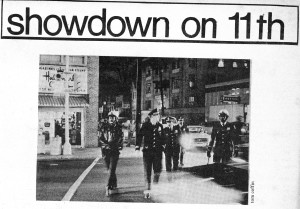 People are putting the paper to bed Tuesday night when that old familiar call comes: “Pigs are busting people on 11th Street.” So our crack riot-trained team of reporters and photogs converge on the scene, to find: a big red fire truck, brandishing its fire hoses at a still (slightly) smoldering can of garbage; a Journal/Constitution, paper-box (Right On!) blocking the Peachtree entrance onto 11th; a small scattering of freaks (“Community People” we call them) hustling and bustling about in customary gaiety, exclaiming on the near riot; and the familiar voice of Harky (The Rev. Klinefelter)’first far away, then nearing and finally turning the corner of Peachtree onto llth.
People are putting the paper to bed Tuesday night when that old familiar call comes: “Pigs are busting people on 11th Street.” So our crack riot-trained team of reporters and photogs converge on the scene, to find: a big red fire truck, brandishing its fire hoses at a still (slightly) smoldering can of garbage; a Journal/Constitution, paper-box (Right On!) blocking the Peachtree entrance onto 11th; a small scattering of freaks (“Community People” we call them) hustling and bustling about in customary gaiety, exclaiming on the near riot; and the familiar voice of Harky (The Rev. Klinefelter)’first far away, then nearing and finally turning the corner of Peachtree onto llth.